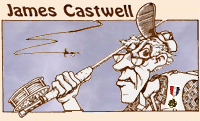|
It is said "Write only about that which you know something." This therefore should
be rather short, but probably won't be. Lately I have found some time to venture
forth and pester some native Chum salmon which are staging at the mouth of one
of my local streams. A few periodically do ascend the creek itself to spawn. The area
will support many fishers and I have been watching as they try to catch a fish. This is
a popular spot at this time of year and the variety of casting techniques is as varied as
are those who show up. No two seem to have graduated from the same 'school-of-casting.'
But that is not what is so remarkable. In their defense I will admit I have been in
the same stage of 'emotional confusion' myself. For the most part nearly all can get
the line to hit the water in front of themselves more often than it hits behind. Always
an encouraging sign. If I were asked what is the single most common error made by
98% it would be this. They pay no attention to 'reading the water.' Cast it out, stip it
in and cast it out again as fast as possible.
I suppose they are justified in not doing so; but it is to their detriment. This is a tide
situation and the water level is constantly changing. This causes the currents to constantly
switch as the bottom is not even, with many small depressions scattered about. The fish
live in this stuff and react to the changing environment. I have seen other fly-fishers
completely ignore changing tide rips, currents, slicks and directions many times in the
past also.
How do you learn to 'read the water?' By watching, thinking, figuring out where a
fish would be at all times. Be observant of all changing conditions; wind speed,
direction, surface disturbances, every little thing relating to the water where you
are fishing. Sure, you must concentrate on rises, etc, but, the fish will follow the
patterns of the water, then attempt food if possible. Learn to think like a fish.
There is one condition that occurs where I often fish that is a beach type with a
few waves that come into shore. When there is a major tide change, for a few
minutes some waves will generate rising to nearly four feet high. As they hit the
shore line, most fly-fishers step back out of the water as attempting to fly-cast in
that severely tangles any fly line laying on the water. I step back from shore as
well, but, I continue false casting and continue until I have as much line in the air
as possible, then time my cast and pitch it as far into the breakers as possible.
That method has resulted in two nearly identical large chinook salmon. They
were following and feasting on the bait fish swirling in the breaking surf.

This is not brilliant thinking on my part. Fish where the fish are; you will get more.
When I am fishing with others, I probably cast fewer times than those with me, and
mostly catch more fish then they do. When that happens it is usually because I have
been studying the water a bit more than they.
It is not easy to take the time to force yourself to study the water when your impulse
is to make another cast just as darn fast as you can so you can get a fish. But, it pays
big dividends and often rather quickly. This will also give you a fuller appreciation of
your environment and appreciation for the recreation as well. Try it, it works for me
even on small streams where there is no tide. ~ James Castwell
|





